人教版新目标版七年级英语上册Unit 1 My name’s Gina教材解读
- 格式:doc
- 大小:78.50 KB
- 文档页数:2
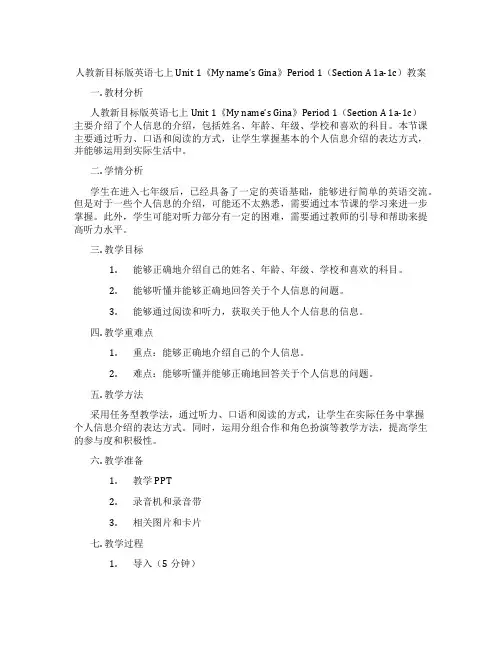
人教新目标版英语七上Unit 1《My name’s Gina》Period 1(Section A 1a-1c)教案一. 教材分析人教新目标版英语七上Unit 1《My name’s Gina》Period 1(Section A 1a-1c)主要介绍了个人信息的介绍,包括姓名、年龄、年级、学校和喜欢的科目。
本节课主要通过听力、口语和阅读的方式,让学生掌握基本的个人信息介绍的表达方式,并能够运用到实际生活中。
二. 学情分析学生在进入七年级后,已经具备了一定的英语基础,能够进行简单的英语交流。
但是对于一些个人信息的介绍,可能还不太熟悉,需要通过本节课的学习来进一步掌握。
此外,学生可能对听力部分有一定的困难,需要通过教师的引导和帮助来提高听力水平。
三. 教学目标1.能够正确地介绍自己的姓名、年龄、年级、学校和喜欢的科目。
2.能够听懂并能够正确地回答关于个人信息的问题。
3.能够通过阅读和听力,获取关于他人个人信息的信息。
四. 教学重难点1.重点:能够正确地介绍自己的个人信息。
2.难点:能够听懂并能够正确地回答关于个人信息的问题。
五. 教学方法采用任务型教学法,通过听力、口语和阅读的方式,让学生在实际任务中掌握个人信息介绍的表达方式。
同时,运用分组合作和角色扮演等教学方法,提高学生的参与度和积极性。
六. 教学准备1.教学PPT2.录音机和录音带3.相关图片和卡片七. 教学过程1.导入(5分钟)利用图片和卡片,引导学生进行关于个人信息的问答,激发学生的兴趣。
例如:教师出示一张图片,问学生:“What’s her name? How old is she?”等。
2.呈现(5分钟)教师播放录音,让学生听懂并回答关于个人信息的问题。
录音内容为:不同人介绍自己的姓名、年龄、年级、学校和喜欢的科目。
例如:A: My name’s Gina. I’m twelve. I’m in Grade Seven. I like math. B: My name’s Tom. I’m eleven. I’m in Grade Six. I like Chinese. 等。
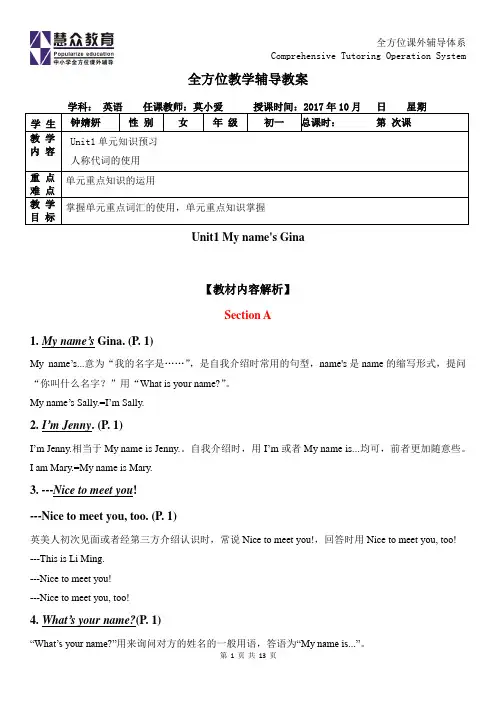
全方位教学辅导教案学生钟婧妍性别女年级初一总课时:第次课教学内容Unit1单元知识预习人称代词的使用重点难点单元重点知识的运用教学目标掌握单元重点词汇的使用,单元重点知识掌握Unit1 My name's Gina【教材内容解析】Section A1.My name’s Gina. (P. 1)My name’s...意为“我的名字是……”,是自我介绍时常用的句型,name's是name的缩写形式,提问“你叫什么名字?”用“What is your name?”。
My name’s Sally.=I’m Sally.2.I’m Jenny. (P. 1)I’m Jenny.相当于My name is Jenny.。
自我介绍时,用I’m或者My name is...均可,前者更加随意些。
I am Mary.=My name is Mary.3. ---Nice to meet you!---Nice to meet you, too. (P. 1)英美人初次见面或者经第三方介绍认识时,常说Nice to meet you!,回答时用Nice to meet you, too! ---This is Li Ming.---Nice to meet you!---Nice to meet you, too!4.What’s your name?(P. 1)“What’s your name?”用来询问对方的姓名的一般用语,答语为“My name is...”。
---What’s your name?---I’m Mary/My name is Mary.5.I’m Ms. Brown. (P. 1)Ms.意为“女士”,用于女子的姓氏或者姓名前,不指明是否结婚。
Ms. Green is our math teacher.6.And what’s her name? (P. 2)and用作连词,意为“而且、又、和”,本句中的and起到承上启下的作用。
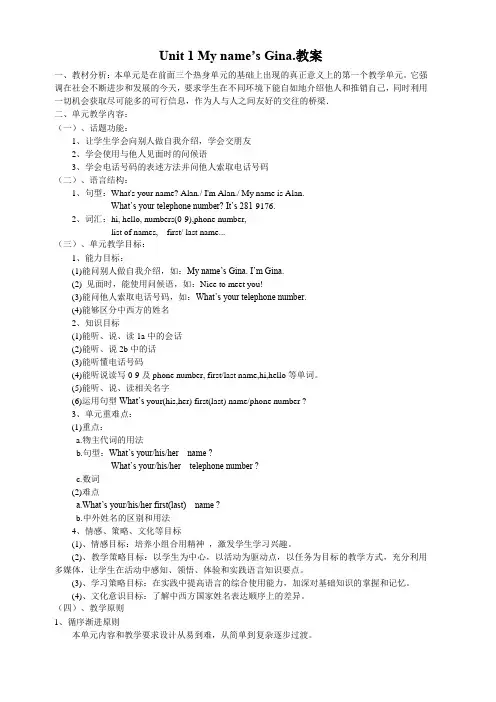
Unit 1 My name’s Gina.教案一、教材分析:本单元是在前面三个热身单元的基础上出现的真正意义上的第一个教学单元。
它强调在社会不断进步和发展的今天,要求学生在不同环境下能自如地介绍他人和推销自己,同时利用一切机会获取尽可能多的可行信息,作为人与人之间友好的交往的桥梁.二、单元教学内容:(一)、话题功能:1、让学生学会向别人做自我介绍,学会交朋友2、学会使用与他人见面时的问候语3、学会电话号码的表述方法并问他人索取电话号码(二)、语言结构:1、句型:What's your name? Alan./ I'm Alan./ My name is Alan.What’s your telephone number? It’s 281-9176.2、词汇:hi, hello, numbers(0-9),phone number,list of names, first/ last name...(三)、单元教学目标:1、能力目标:(1)能问别人做自我介绍,如:My name’s Gina. I’m Gina.(2) 见面时,能使用问候语,如:Nice to meet you!(3)能问他人索取电话号码,如:What’s your telephone number.(4)能够区分中西方的姓名2、知识目标(1)能听、说、读1a中的会话(2)能听、说2b中的话(3)能听懂电话号码(4)能听说读写0-9及phone number, first/last name,hi,hello等单词。
(5)能听、说、读相关名字(6)运用句型What’s your(his,her) first(last) name/phone number ?3、单元重难点:(1)重点:a.物主代词的用法b.句型:What’s your/his/her name ?What’s your/his/her telephone number ?c.数词(2)难点a.What’s your/his/her first(last) name ?b.中外姓名的区别和用法4、情感、策略、文化等目标(1)、情感目标:培养小组合用精神,激发学生学习兴趣。
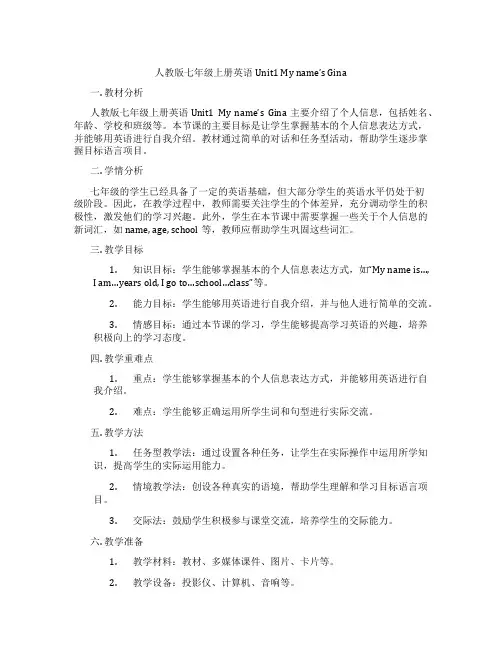
人教版七年级上册英语Unit1 My name’s Gina一. 教材分析人教版七年级上册英语Unit1 My name’s Gina主要介绍了个人信息,包括姓名、年龄、学校和班级等。
本节课的主要目标是让学生掌握基本的个人信息表达方式,并能够用英语进行自我介绍。
教材通过简单的对话和任务型活动,帮助学生逐步掌握目标语言项目。
二. 学情分析七年级的学生已经具备了一定的英语基础,但大部分学生的英语水平仍处于初级阶段。
因此,在教学过程中,教师需要关注学生的个体差异,充分调动学生的积极性,激发他们的学习兴趣。
此外,学生在本节课中需要掌握一些关于个人信息的新词汇,如name, age, school等,教师应帮助学生巩固这些词汇。
三. 教学目标1.知识目标:学生能够掌握基本的个人信息表达方式,如“My name is…,I am…years old, I go to…school…class”等。
2.能力目标:学生能够用英语进行自我介绍,并与他人进行简单的交流。
3.情感目标:通过本节课的学习,学生能够提高学习英语的兴趣,培养积极向上的学习态度。
四. 教学重难点1.重点:学生能够掌握基本的个人信息表达方式,并能够用英语进行自我介绍。
2.难点:学生能够正确运用所学生词和句型进行实际交流。
五. 教学方法1.任务型教学法:通过设置各种任务,让学生在实际操作中运用所学知识,提高学生的实际运用能力。
2.情境教学法:创设各种真实的语境,帮助学生理解和学习目标语言项目。
3.交际法:鼓励学生积极参与课堂交流,培养学生的交际能力。
六. 教学准备1.教学材料:教材、多媒体课件、图片、卡片等。
2.教学设备:投影仪、计算机、音响等。
七. 教学过程1.导入(5分钟)教师通过展示一张学生的照片,引导学生猜测照片中的人是谁,从而引出本节课的主题——介绍个人信息。
2.呈现(10分钟)教师展示教材中的插图,引导学生观察图中的人物,并根据图中的提示,让学生尝试说出人物的姓名、年龄、学校和班级等信息。
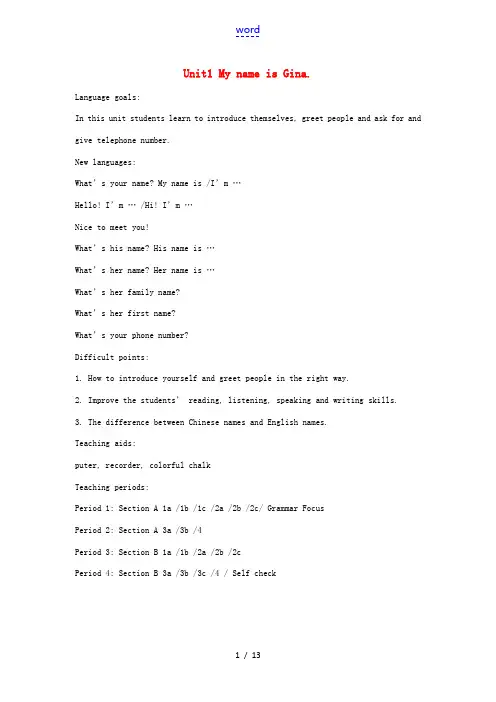
Unit1 My name is Gina.Language goals:In this unit students learn to introduce themselves, greet people and ask for and give telephone number.New languages:What’s your name? My name is /I’m …Hello! I’m … /Hi! I’m …Nice to meet you!What’s his name? His name is …What’s her name? Her name is …What’s her family name?What’s her first name?What’s your phone number?Difficult points:1. How to introduce yourself and greet people in the right way.2. I mprove the students’ reading, listening, speaking and writing skills.3. The difference between Chinese names and English names.Teaching aids:puter, recorder, colorful chalkTeaching periods:Period 1: Section A 1a /1b /1c /2a /2b /2c/ Grammar FocusPeriod 2: Section A 3a /3b /4Period 3: Section B 1a /1b /2a /2b /2cPeriod 4: Section B 3a /3b /3c /4 / Self checkPeriod 1Teaching aims:1. Memorize the words on page1and page2.2. Learn the target languages:My name is Gina.What’s your name?Hello! I’m Mary.Hi! I’m Jim.What’s his name?What’s her name?3. Train the listening and speaking skills.Teaching procedure:Step 1 Free talkLet students talk in pairs using the sentences they’ve learned in Starter or ask some questions in Starter, have students answer them. For example: Good morning/afternoon/evening!How are you?What’s this in English?What color is it?Step 2 Section A 1aThis activity tests students’ vocabulary.1. Draw student’s attention to the pictures. Point to an object in it andask what it is. Say, now look at the picturesand write down as many words as you can2. Ask two students to write the words on the blackboard.3. Check the students’ answers. Ask some students to call out their wordsand spell them. Write down the words on the board.Step3 Section A 1bThis activity gives students practice in understanding the target language in spoken conversation.Read the instruction to the students. Make sure the students understand how to do it. Say, now listen and number the conversations 1-3.(1) Play the recording for the first time. Students only listen.(2) Play the recording a second time. Students number the conversations.(3) Check the answers together.Step 4 Section A 1cThis activity provides guided oral practice using the target language.(1) Ask three pairs to read the conversations in 1b. If necessary, ask studentsto repeat the names after the teacher.(2) Have students work in pairs to practice the conversations.(3) Say, Now use your own names when you have conversations .Move around theroom monitoring their work. Offer language or pronunciation support asneeded.(4) Let several pairs e to the front of the class and act out theirconversations.Step 5 Section A 2aThis activity gives students practice in understanding the key words and target languages.1. Point to a boy and a girl. Say, His name is---, her name is--- Have studentsunderstand the meaning of his and her.2. Read the instruction to the students.3. Play the recording for the first time. Students only listen.4. Play the recording a second time. Students number the pictures 1-4.5. Check the answers.Step 6Section A 2bThis activity provides listening practice.(1) Have one student read the names in the box.(2) Say, listen to the four conversations again.This time circle the names you hear.(3) Students listen and circle the names.(4) Check the answers.Step 7 Section A 2cThis activity provides guided oral practice using the target language.(1) Call attention to the two conversations in the box.Ask one pair to act out the first one. Tell them to use their own names.Ask another pair to act out the second one.Have them point to a boy or a girl when they ask the questions:What’s his name/What’s her name?(2) Let students work in pairs to practice the two conversations. As studentswork, move around the classroom, monitoring the conversations andoffering assistance if necessary.(3) Have several pairs of students present their conversations to the class. Step 8Grammar Focus(1) Divide the class into two groups to say the questions and responses.(2) Write down the full forms and contractions of the words on the right.Have students pare them. Then ask them to say the sentences in two ways. Step 9 Conclusion(1) Learn the words and phrases.(2) Master the target languages:My name is Gina.What’s your name?Hello! I’m Mary.Hi! I’m Jim.What’s his name?What’s her name?Step 10 Homework(1) Learn the words by heart.(2) Practice the conversations in 1b and Grammar Focus.(3) Do some preparing.Period 2Teaching aims:1. Memorize the words and phrases: first, first name, last, last name, boy, girl2. Learn about first name and last name.3. Train writing and speaking skills.Teaching procedure:Step 1 Revision1. Go over the words in last class. (Play a game. Divide the class into twogroups: boys and girls. Give them three minutes to read and write the words.Then look at the Chinese meaning on the cards. See which group can say andspell the words more quickly and correctly. )2. Ask students to make conversations about introduction and greeting. Step 2 SectionA 3aThis activity introduces the western concept of first name and last name.1. Write down a Chinese name and an English name on the board. For example:Deng Yaping and Jim Smith.2. Ask students to discuss the names. Encourage them to tell the differencebetween them. (English names are listed with the given name first and thefamily name or surname second. While Chinese names are listed with thefamily name first and given name second.)3. Ask some students to say their family names and first names.4. Have two students read the list of names in the box. Say, Guess, whichnames are first names and which are last names?5. Ask students to write F for first name and L for last name next to thewords. Students do the exercise by themselves.6. Check the answers.Step3 Work in pairs(1) Call attention to the picture on the right. Students look at the pictureand the sentences carefully. Have them pay attention to what the teacherwrites.(2) Have two students read the conversations in the picture aloud.(3) Ask students to work in pairs.Ask and answer about their first names and last names.Step4 SectionA 3bThis activity provides guided oral practice using the target language.(1) Point to the names in 3a.( You can write more names on the board.)(2) Say, Which names would you like to choose as your first name and lastname? Now choose your names.(3) Have students take turns to ask and answer the questions (using theirnew names):What’s your first name?What’s your last name?Students make a list of names.Then exchange their lists to correct any mistake they make.Step5 SectionA 4 (Game)This activity gives students an opportunity to practice target language in an interesting way.1. Demonstrate the game with three students.2. Say, Now in groups of four, play the game. As they work, move around theclassroom making sure students understand the procedure and correcting anymistake.3. Ask two groups to present their games to the class.Step 6 Conclusion(1) Learn the words and phrases in this class.(2) Grasp the target languages:What’s your first name?What’s your last name?Step 7 Homework(1) Memorize the words and phrases.(2) Make a conversation about asking for first name and last name.(3) Prepare next lesson.Period 3Teaching aims:1. Memorize the words on page4.2. Target languages:What’s your phone number?It’s …3. Train the listening and speaking skills.Teaching procedure:Step 1 Free talkLet students work in pairs. Make conversations using the target languages they’ve learned. For example:What’s your name? My name is …What’s his name? His name is …What’s her name? Her name is …What’s your first name?What’s your last name?Step 2 Section B 1aThis activity learns the numbers from 0 to nine.(1) Write the numbers 0-9 on the board. Ask who can say them in English.Encourage more students to read them.(2) Play the recording for the first time. Students only listen.(3) Play the recording a second time. Have students repeat the numbers.(4) Give students two or three minutes to read and write the mummers. Thenhave some students say them quickly and ask if anybody can spell them.Cheer for the students who do best.Step3 Section B 1bThis activity gives students practice recognizing the numbers 0-9 in spoken telephone numbers.Say, Now listen to the conversation, and write down the telephone number you hear.(1) Play the recording for the first time. Students only listen.(2) Play the recording a second time.Have students write the numbers in the blank.(3)Check the answers.(4) Work in pairs and practice the conversation.Step 4 Section B 1cThis activity gives students speaking practice using the target language.(1) Call attention to the conversation on the right. Have two students read it.(2) Practice the conversation in pairs.(3) Say,Now in groups of three or four, make up conversations using any phonenumber you like .As they work, move around the room monitoring their work.Offer language or pronunciation support as needed.(4) Let several pairs e to the front of the class to perform theirconversations for the class.Step 5 Section B 2aThis activity provides listening practice with the target language.1. Call attention to the names and the numbers in the box.2. Read each one to the class or ask some students to read them.3. Point to the blanks in the four telephone numbers. Say, The phone numbersaren’t finished. You need to write the last two numbers later. Now listenand match the names with the telephone numbers.4. Play the recording for the first time. Students only listen.5. Play the recording a second time Students write the letter of the person’stelephone number in the space after that person’s name.6. Check the answers.Step 6Section B 2bThis activity gives students practice recognizing the spoken numbers 0-9. (1) Say, Now let’s listen to the conversations again and finish each telephonenumber.(2) Students listen and fill in the missing numbers.(3) Check the answers.(4) If have time, have students repeat the telephone number after the recording.(5) Practice the four conversations in pairs.Step 7 Section B 2cThis activity provides guided oral practice using the target language.(1) Call attention to the address book. Ask one student,“What’s your phone number?” Write his/her name and phone number inthe address book.Make sure all the students understand how to fill in the address book.(2) Say, Now ask your four classmates their phone numbers and fill in theform.Step 8 Conclusion(1) Learn the numbers 0-9.(2) How to asking for phone number:What’s your phone number?It’s …Step 9 Homework(1) Remember the numbers from 0 to 9.(2) Make two conversations.(3) Do some preparing.Period 4Teaching aims:1. Memorize the words and phrases on page2. How to ask for first names/last names/phone numbers.3. Train speaking and writing skills.Teaching procedure:Step 1 Revision1. Go over the numbers in last class.Ask the students to read and spell numbers from 0-9.2. Talk about phone numbers.Step 2 Section B 3aThis activity reviews about first name and last name.1. Say, Look at the picture. How many cards can you see?Can you read the names on the card?2. Ask four students to read the names on each card. Then say,“Which is first name and which is last name? Do you know?”3. Point out the blank line following each first name in the exercise.Say, Write each person’s last name in the blank after the first name.4. Students finish the exercise individually.5. Check the answers.Step 3 Section B 3b & 3cThis activity provides speaking and writing practice using the target language.(1) Point to the ID card. Say, Look at the girl on the card. What’s hertelephone number? What’s her family name? What’s her first name?(2) Have students work in pairs and answer the three questions.(3) Check the answers.(4) Say, Look at the ID card in 3c. This is your card. Write your own firstname, last name, and telephone number on it.(5) As students work, move around the room checking progress.Step 4 Section B 4This activity gives students an opportunity to practice target language ina game.Read the instruction to the class. Make sure all the students know how to do it. Move around the room monitoring their work. Offer language or pronunciation support as needed.。
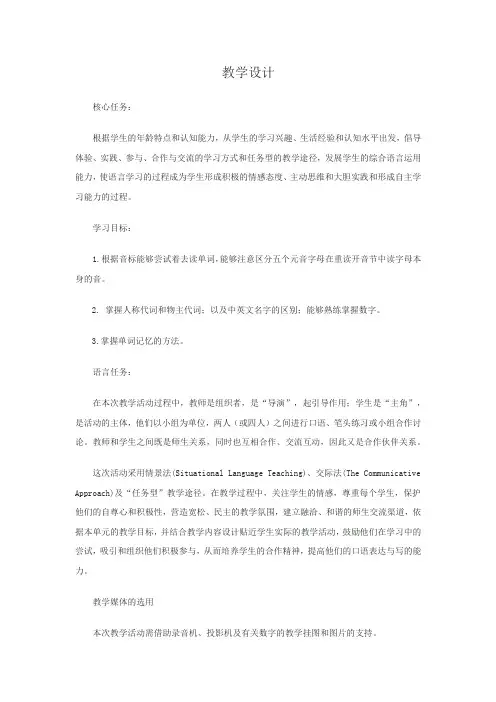
教学设计核心任务:根据学生的年龄特点和认知能力,从学生的学习兴趣、生活经验和认知水平出发,倡导体验、实践、参与、合作与交流的学习方式和任务型的教学途径,发展学生的综合语言运用能力,使语言学习的过程成为学生形成积极的情感态度、主动思维和大胆实践和形成自主学习能力的过程。
学习目标:1.根据音标能够尝试着去读单词,能够注意区分五个元音字母在重读开音节中读字母本身的音。
2. 掌握人称代词和物主代词;以及中英文名字的区别;能够熟练掌握数字。
3.掌握单词记忆的方法。
语言任务:在本次教学活动过程中,教师是组织者,是“导演”,起引导作用;学生是“主角”,是活动的主体,他们以小组为单位,两人(或四人)之间进行口语、笔头练习或小组合作讨论。
教师和学生之间既是师生关系,同时也互相合作、交流互动,因此又是合作伙伴关系。
这次活动采用情景法(Situational Language Teaching)、交际法(The Communicative Approach)及“任务型”教学途径。
在教学过程中,关注学生的情感,尊重每个学生,保护他们的自尊心和积极性,营造宽松、民主的教学氛围,建立融洽、和谐的师生交流渠道,依据本单元的教学目标,并结合教学内容设计贴近学生实际的教学活动,鼓励他们在学习中的尝试,吸引和组织他们积极参与,从而培养学生的合作精神,提高他们的口语表达与写的能力。
教学媒体的选用本次教学活动需借助录音机、投影机及有关数字的教学挂图和图片的支持。
本教材的特点之一就是每个单元都有任务型听力练习及多种其它听力练习,因此录音机是必不可少的;而投影机对帮助学生做笔头练习提供了极大的方便;使用教学挂图和图片对掌握本单元的单词及核心语言活动,显得更为形象和直观,学生更有兴趣,印象更深。
教学和活动过程活动目的:学习和巩固人称代词和物主代词及数字的单词,会掌握用英语表达向别人介绍自己或他人的语言活动。
教学过程和步骤:1、听A E I O U 的chant ,复习五个元音字母的发音,也是为了活跃课堂气氛。
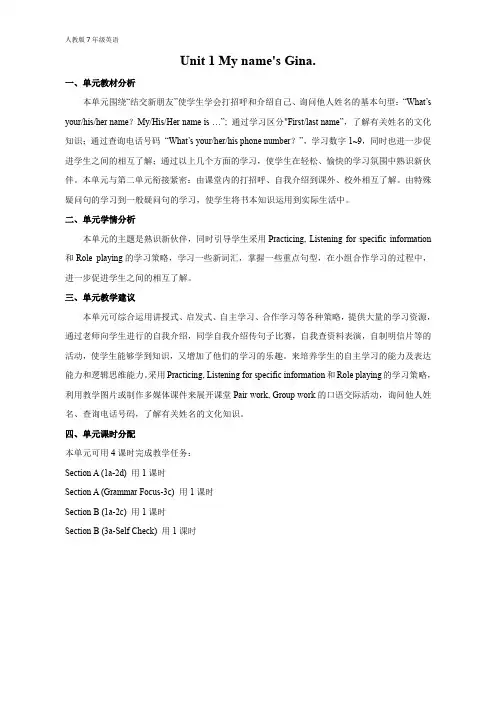
Unit 1 My name's Gina.一、单元教材分析本单元围绕“结交新朋友”使学生学会打招呼和介绍自己、询问他人姓名的基本句型:“What’s your/his/her name?My/His/Her name is …”; 通过学习区分"First/last name”,了解有关姓名的文化知识;通过查询电话号码“What’s your/her/his phone number?”,学习数字1~9,同时也进一步促进学生之间的相互了解;通过以上几个方面的学习,使学生在轻松、愉快的学习氛围中熟识新伙伴。
本单元与第二单元衔接紧密:由课堂内的打招呼、自我介绍到课外、校外相互了解。
由特殊疑问句的学习到一般疑问句的学习,使学生将书本知识运用到实际生活中。
二、单元学情分析本单元的主题是熟识新伙伴,同时引导学生采用Practicing, Listening for specific information 和Role playing的学习策略,学习一些新词汇,掌握一些重点句型,在小组合作学习的过程中,进一步促进学生之间的相互了解。
三、单元教学建议本单元可综合运用讲授式、启发式、自主学习、合作学习等各种策略,提供大量的学习资源,通过老师向学生进行的自我介绍,同学自我介绍传句子比赛,自我查资料表演,自制明信片等的活动,使学生能够学到知识,又增加了他们的学习的乐趣。
来培养学生的自主学习的能力及表达能力和逻辑思维能力。
采用Practicing, Listening for specific information和Role playing的学习策略,利用教学图片或制作多媒体课件来展开课堂Pair work, Group work的口语交际活动,询问他人姓名、查询电话号码,了解有关姓名的文化知识。
四、单元课时分配本单元可用4课时完成教学任务:Section A (1a-2d) 用1课时Section A (Grammar Focus-3c) 用1课时Section B (1a-2c) 用1课时Section B (3a-Self Check) 用1课时Section A (1a-2d)一、教学目标:1. 语言知识目标:1) 能掌握以下单词:name nice meet his and her your能掌握以下句型:①—Hi. My name’s Gina. —I’m Jenny. Nice to meet you!②—What’s your/his/her name? —My/his her name is…③—Are you…? —Yes, I am. / No, I'm not.④—Is he/she…? —Yes, she/he is. / No, she/he isn’t.2) 能了解以下语法:your, his, her等形容词性物主代词的简单用法;What’s=what is I’m=I am name’s=na me is等缩写形式。
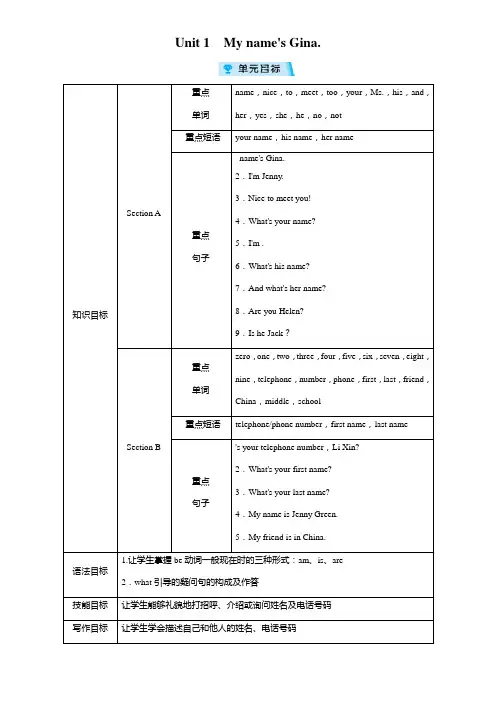
Unit 1My name's Gina.知识目标Section A重点单词name,nice,to,meet,too,your,Ms.,his,and,her,yes,she,he,no,not重点短语your name,his name,her name重点句子name's Gina.2.I'm Jenny.3.Nice to meet you!4.What's your name?5.I'm .6.What's his name?7.And what's her name?8.Are you Helen?9.Is he Jack?Section B重点单词zero,one,two,three,four,five,six,seven,eight,nine,telephone,number,phone,first,last,friend,China,middle,school重点短语telephone/phone number,first name,last name重点句子's your telephone number,Li Xin?2.What's your first name?3.What's your last name?4.My name is Jenny Green.5.My friend is in China.语法目标1.让学生掌握be动词一般现在时的三种形式:am、is、are2.what引导的疑问句的构成及作答技能目标让学生能够礼貌地打招呼、介绍或询问姓名及电话号码写作目标让学生学会描述自己和他人的姓名、电话号码情感目标鼓励学生结交新朋友第一课时Section A(1a-2d)重点单词name n. 名字;名称nice adj. 令人愉快的;宜人的to 常用于原形单词前,表示该动词为不定式meet v. 遇见;相逢too ad v. 也;又;太your pron. 你的;你们的Ms. 女士his pron. 他的and conj. 和;又;而her pron.她的yes interj. 是的;可以she pron. 她he pron. 他no ad v.& adj. 不;没有;不是not ad v. 不;没有重点短语your name 你的名字his name 他的名字her name 她的名字重点句子name's Gina. 我的名字叫吉娜。
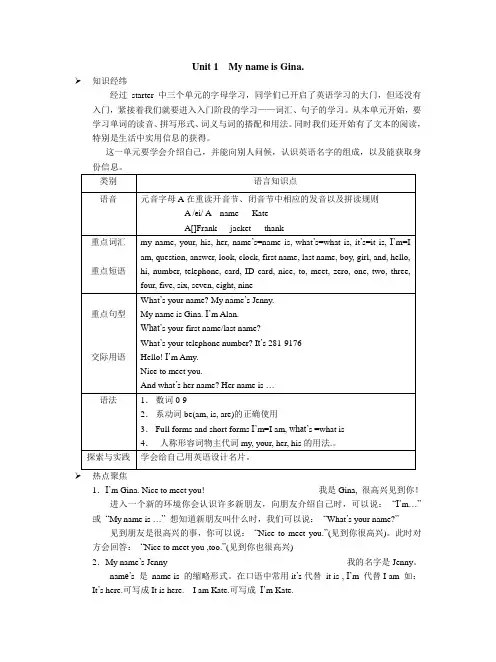
Unit 1 My name is Gina.知识经纬经过starter 中三个单元的字母学习,同学们已开启了英语学习的大门,但还没有入门,紧接着我们就要进入入门阶段的学习——词汇、句子的学习。
从本单元开始,要学习单词的读音、拼写形式、词义与词的搭配和用法。
同时我们还开始有了文本的阅读,特别是生活中实用信息的获得。
这一单元要学会介绍自己,并能向别人问候,认识英语名字的组成,以及能获取身份信息。
热点聚焦1.I’m Gina. Nice to meet you! 我是Gina, 很高兴见到你!进入一个新的环境你会认识许多新朋友,向朋友介绍自己时,可以说:“I’m…”或“My name is …”想知道新朋友叫什么时,我们可以说:“What’s your name?”见到朋友是很高兴的事,你可以说:“Nice to meet you.”(见到你很高兴)。
此时对方会回答:“Nice to meet you ,too.”(见到你也很高兴)2.My name’s Jenny 我的名字是Jenny。
nam e’s 是name is 的缩略形式。
在口语中常用it’s代替it is , I’m 代替I am 如:It’s here.可写成It is here. I am Kate.可写成I’m Kate.3.What’s your phone number? It’s 281-9176. 你的电话号码是什么?是281-9176。
What’s …是口语中常用的一个句型,除了用语询问别人的姓名外,还可用语询问电话号码、数字和时间等许多情况。
如:What’s his e-mail address? 他的电子邮件地址是什么?What’s….number? 是用来对自行车牌号、房间号、电话号码、身份证号码等进行提问,回答是I t’s + 号码。
还有一种提问方式是:What’s the number of …? 如:What’s the number of your telephone? 你的电话号码是多少?4.What’s her family/last name? What’s her first name? 她的姓是什么?她的名是什么?family name 姓氏last name姓氏first name名字英语姓名的结构一般为:first name(given name) last name(family name),名在前,姓在后。
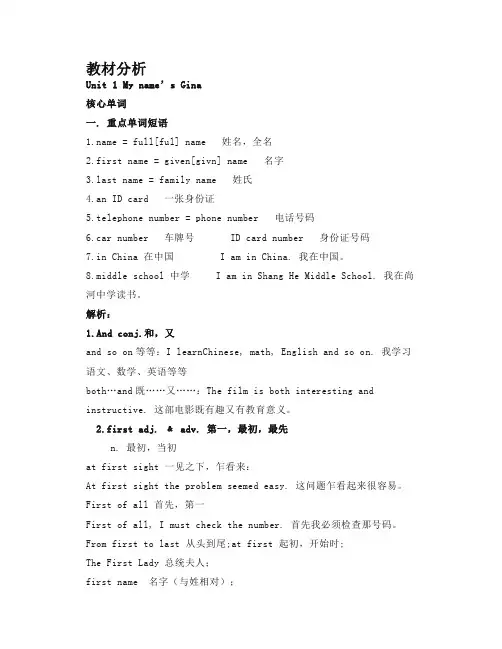
教材分析Unit 1 My name’s Gina核心单词一. 重点单词短语 = full[ful] name 姓名,全名2.first name = given[givn] name 名字st name = family name 姓氏4.an ID card 一张身份证5.telephone number = phone number 电话号码6.car number 车牌号 ID card number 身份证号码7.in China 在中国 I am in China. 我在中国。
8.middle school 中学 I am in Shang He Middle School. 我在尚河中学读书。
解析:1.And conj.和,又and so on等等:I learnChinese, math, English and so on. 我学习语文、数学、英语等等both…and既……又……:The film is both interesting and instructive. 这部电影既有趣又有教育意义。
2.first adj. ﹠ adv. 第一,最初,最先n. 最初,当初at first sight 一见之下,乍看来:At first sight the problem seemed easy. 这问题乍看起来很容易。
First of all 首先,第一First of all, I must check the number. 首先我必须检查那号码。
From first to last 从头到尾;at first 起初,开始时;The First Lady 总统夫人;first name 名字(与姓相对);first – aid 急救的;first cost (商)最初成本。
3.One num. 一拓展:one还可以做代词,代替上文中已提过的或是已知的事物。
I need a pencil.Can you lend me one ?名言:One swallow does not makea summer.(一燕不成夏。
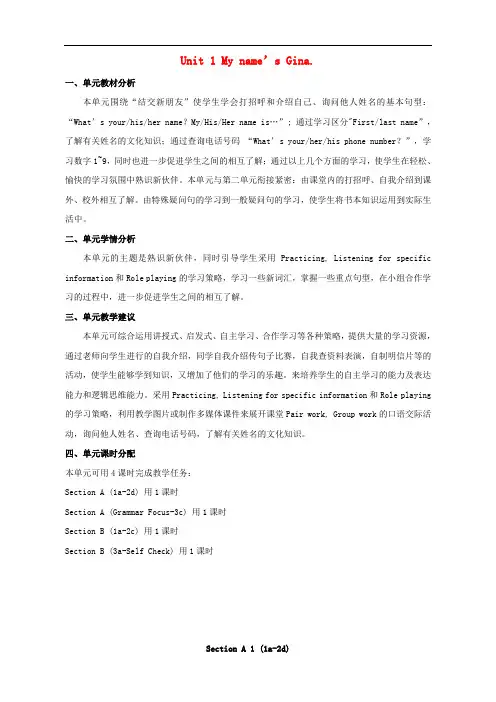
Unit 1 My name’s Gina.一、单元教材分析本单元围绕“结交新朋友”使学生学会打招呼和介绍自己、询问他人姓名的基本句型:“What’s your/his/her name?My/His/Her name is…”; 通过学习区分"First/last name”,了解有关姓名的文化知识;通过查询电话号码“What’s your/her/his phone number?”,学习数字1~9,同时也进一步促进学生之间的相互了解;通过以上几个方面的学习,使学生在轻松、愉快的学习氛围中熟识新伙伴。
本单元与第二单元衔接紧密:由课堂内的打招呼、自我介绍到课外、校外相互了解。
由特殊疑问句的学习到一般疑问句的学习,使学生将书本知识运用到实际生活中。
二、单元学情分析本单元的主题是熟识新伙伴,同时引导学生采用Practicing, Listening for specific information和Role playing的学习策略,学习一些新词汇,掌握一些重点句型,在小组合作学习的过程中,进一步促进学生之间的相互了解。
三、单元教学建议本单元可综合运用讲授式、启发式、自主学习、合作学习等各种策略,提供大量的学习资源,通过老师向学生进行的自我介绍,同学自我介绍传句子比赛,自我查资料表演,自制明信片等的活动,使学生能够学到知识,又增加了他们的学习的乐趣。
来培养学生的自主学习的能力及表达能力和逻辑思维能力。
采用Practicing, Listening for specific information和Role playing 的学习策略,利用教学图片或制作多媒体课件来展开课堂Pair work, Group work的口语交际活动,询问他人姓名、查询电话号码,了解有关姓名的文化知识。
四、单元课时分配本单元可用4课时完成教学任务:Section A (1a-2d) 用1课时Section A (Grammar Focus-3c) 用1课时Section B (1a-2c) 用1课时Section B (3a-Self Check) 用1课时Section A 1 (1a-2d)一、教学目标:1. 语言知识目标:1) 能掌握以下单词: name nice meet his and her your能掌握以下句型:① —Hi. My name’s Gin a.—I’m Jenny. Nice to meet you!② —What’s your/his/her name?—My/His/H er name is…③ —Are you…?—Yes, I am. / No, I'm not.④ —Is he/she…?—Yes, she/he is. / No, she/he isn’t.2) 能了解以下语法:your, his, her等形容词性物主代词的简单用法;What’s=what is I’m=I am name’s=name is等缩写形式。
过程设计Lead-in: greeting with students and review.Step One: 1. Listen the song “Ten Little Indian Boys”.Teacher: During the first two classes, we’ve known somethingabout new friends names. But if we want to contact them. Whatshall we do?S1: A telephone call.T: But you don’t have their telephone numbers.S1: Ask for their telephone numbers.T: If we want to know about their telephone numbers, we must learn how to say these numbers in English. Let’s learn to sing “Ten Little Indian Boys”.(After singing the song, tell the students not to forget “zero”.)T: Count the number together from zero to nine.S2: Zero…Step2. Listen the type and read numbers from0-9.T: now, let’s listen this numbers together.( after listen, have students read numbers together ,every two times.)Step3: List phone number in life.T: number is common in our life, here I have some telephone number,can you read it and tell me when we need it? ( list numbers like 110, 120, 911)S:one one zero, one two, zero......Step 4.Listen to the conversation and write the telephone 1歌曲欢快有趣,比起单纯教授单词更为有效,通过歌曲呃呃歌词引导学生感知数字。
教学案例Unit1 My name’s Gina.( Section A)教材分析:教学内容为《新目标》英语7年级上册Unit1,Section A。
学习内容主要体现以下几点:1.掌握介绍自己和问候他人的句型:What’s your name? My name’s Gina. Nice to meet you!2.掌握Be的一般现在时形式3.掌握What引导的特殊疑问句4.掌握形容词性物主代词:my, your, his, her能力目标:1.通过教学,引导学生学会问候他人和学会如何做自我介绍;能从对话中获取对方的基本信息;建立班级电话号码簿;学会制作个性名片;能向他人简单地介绍自己名字的含义。
2.培养语言能力,让学生把所学到的语言知识和生活实际联系起来,使学习过程生活化。
3.学会一些基本的学习策略,听说领先,读写跟上的策略,在起始阶段反复跟读磁带,标上语调,模仿纯正的美语4.培养用英语思维的能力和创新意识,学会不断发现问题,并用自己已有的知识水平和生活经历来解决实际问题。
如个性化名片的设计,培养了学生的动手能力,展示了学生的个性。
情感目标:1.通过小组对话、讨论、调查和设计等一系列的活动,培养学生的合作意识和团队精神。
2.通过结交新朋友,学会如何礼貌地与他人交往。
交际策略:学会与他人合作交流,并能把语言材料运用到真实的生活中去。
资源策略:学会利用一切可以利用的学习资源,如词典,网络,音像资料,尤其是配套的录音材料来获取更多的信息。
认知能力:积极思考,及时反馈。
调控策略:在反思、顿悟和自醒中不断的调整自己的学习策略。
设计理念:任务型语言教学倡导“在做中学,在做中用”的教育理念,根据这理念,我将任务为中心将语言应用的基本理念转化为具有实践意义的课堂教学方式,运用学习任务组织教学,强化语言实践的过程,充分体现了语言的交际本质。
在英语课堂上,实施任务和开展活动具有很大的挑战性,需要在实际操作中对教材进行重新整合,并要根据学生的环境和接受能力来开展行之有效的任务和活动。
全方位教学辅导教案Unit1 My name's Gina【教材内容解析】Section A1.My name’s Gina. (P. 1)My name’s...意为“我的名字是……”,是自我介绍时常用的句型,name's是name的缩写形式,提问“你叫什么名字”用“What is your name”。
My name’s Sally.=I’m Sally.2.I’m Jenny. (P. 1)I’m Jenny.相当于My name is Jenny.。
自我介绍时,用I’m或者My name is...均可,前者更加随意些。
I am Mary.=My name is Mary.3. ---Nice to meet you!---Nice to meet you, too. (P. 1)英美人初次见面或者经第三方介绍认识时,常说Nice to meet you!,回答时用Nice to meet you, too! ---This is Li Ming.---Nice to meet you!---Nice to meet you, too!4.What’s your name(P. 1)“What’s your name”用来询问对方的姓名的一般用语,答语为“My name is...”。
---What’s your name---I’m Mary/My name is Mary.5.I’m Ms. Brown. (P. 1)Ms.意为“女士”,用于女子的姓氏或者姓名前,不指明是否结婚。
Ms. Green is our math teacher.6.And what’s her name (P. 2)and用作连词,意为“而且、又、和”,本句中的and起到承上启下的作用。
My name is Grace. And you7. ---Are you Helen---Yes, I am.(P. 2)Are you...询问“你是……吗”,肯定回答为Yes, I am.。
Unit 1 My name’s Gina一. [话题](Topic)Greeting people and making new friends二. [重点词组](Key Phrases)book 书textbook 课本notebook 笔记本clock 钟表lock锁door门window 窗户fish鱼paper 纸a piece of paper 一X纸ruler 尺子basketball 篮球baseball 棒球schoolbag 书包handbag 手提包key 钥匙三.[交际用语]1. ——What’s your /his /her name ?——My / His /Her name’s …2. ——What’s your first name /last name ?——My first name / last na me is …3. ——Hi /Hello . I’m …/ My name’s …——Hi . I’m …. Nice to meet you .4. ——What’s your /his /her phone number ?——It’s …四. [重点难点释义](Language Points)1.“What’s your name?”“My name is Gina.”“你叫什么名字?”“我叫吉娜。
”两人初次见面互相询问某某时可用这个句型。
如想反问时可说:And you?或者And what’s your name?如:A:Hello. What’s your name?B:My name is Ann Read. And you?/And what’s your name?A:I’m Han Mei.2.Hello!你好!Hello一般可作为熟人、朋友、青年人之间的招呼用语,语气较随便,译为“您好”;此外打或遇熟人时也可用。
译为“喂”。
在表示问候或唤起注意时,有时可用Hi来代替Hello,显得更为随便。
Unit 1 My name’s Gina.
教材分析
1、教学话题:
Make new friends
2、能力目标:
1)Introduce yourself使学生学会用英语介绍自己。
2)Greet people使学生学会用英语和别人打招呼。
3)Ask for and give telephone numbers 询问和给出电话号码
3、情感目标:
1)让学生初步体会用英语和别人交流的感受,培养学生学习英语的兴趣。
2)通过对英文名字的介绍,对比中西方表达名字的不同,了解中西方文化的差异。
3)通过对西方一些成功人士英文名字的介绍,使学生了解成功是由不懈的努力和艰苦的奋斗得来的。
4)通过介绍英文名字的由来,使学生产生对西方文化的好奇及兴趣。
4、教学目标:
1)词汇目标:
name, nice, to, meet, too, your, Ms., his, and, her, yes, she, he, no, not, zero, one, two, three, four, five, six, seven, eight, nine, telephone, number, phone, telephone/phone number, first, first name, las t, last na me, friend, China, middle, school, middle school
2)语法目标:
一般现在时be的用法
以特殊疑问词what开头的问句
形容词性物主代词my, y our, his, her
What’s=What is I’m=I am My n ame’s=My name is
3)语言目标:
What’s your n ame?
My name is Gina.
I’m Gina.
Nice to m eet you.
What’s your telephone number? It’s….
5、教学重点:
1)词汇:name, nice, to, meet, too, your, Ms., his, and, her, yes, she, he, no, not, zero, one, two, three, four, five, six, seven, eight, nine, teleph one, number, phone, telephone/phone number, first, first name, last, last name, friend, China, middle, school, middle school
2)句型:
What’s your/his/her name?
My/His/Her name is Gina.
What’s your/his/her t elephone number? It’s….
6、教学难点
my/your/his/her等物主代词的用法。